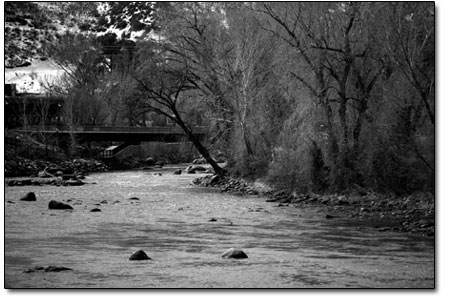|
| ||
| River rescue SideStory: Whitewater Park improvements set for 2010
by Missy Votel The Animas River is getting a facelift. This week, the City of Durango was awarded an $86,000 grant from the Colorado Division of Wildlife for habitat improvements and bank stabilization for the stretch of river between 9th Street and the Highway 160 bridge. The project, which is planned for August, is meant to improve fish habitat while restoring riparian areas along the western river bank. With the high flows and increased use of the area in recent years, a number of native cottonwoods and shrubs along the banks have disappeared, leading to further erosion and habitat damage. “Over the last several years, we’ve lost a lot of our big cottonwoods into the river,” said Ty Churchwell, of the Five Rivers Chapter of Trout Unlimited. “Every time we lose a 150-year-old cottonwood, it takes that long to replace it.” Churchwell said the trees are important because, in addition to providing bird habitat and cover for fish, their massive root systems help to hold the soil in place. Without them, the bank erodes, causing further undercutting. “The root structure is what keeps the soil from washing away. Every big run-off we have, the problem perpetuates itself.” Trout Unlimited along with Animas Riverkeepers was instrumental in securing the grant and getting the City of Durango on board with the project. The area to be worked on, which runs adjacent to Roosa Avenue, is city owned, making city cooperation crucial. The west side of the river, versus the east side adjacent to the River Trail and Doubletree, is being pinpointed because that is where the river takes a natural lefthand turn, scouring the west bank especially hard as a result. “Everything is getting pretty undercut on that part of the river, and right now, there’s not a lot of room between the roadway and the river,” said City of Durango Parks, Open Space and Trails Manager Kevin Hall. The project will incorporate the use of boulders, which the city has been stockpiling, rip rap and native trees and shrubs in an attempt to shore up the bank. “We see this as a test project to see how well this method works,” Hall said. The bank stabilization marks the largest project of its kind on the Animas River in decades. The closest thing to it was the work done a few years back at Dallabetta Park, south of Home Depot, Hall said. The venture will be a pilot project, and if successful, more will likely follow. According to Wegner, the Animas is a classic oxbow river, meaning that over time, it naturally meanders from one side of the valley to the next. However, because of development in town, the river has become unnaturally constrained, giving rise to a host of problems. “The river does what it naturally does upstream in the north valley,” he said. “It has to expend its energy somewhere. And if it has no where to go, it erodes down and destabilizes the bank.” Fortunately, remedying the problem is possible. Similar projects have been down successfully in other urban settings, including the Truckee River, in northern California. “It’s not rocket science,” Wegner said. “It just needs the right people to come together and the money with which to do it.” The project culminates three years of behind the scenes work by TU and Animas Riverkeepers. In addition to funding architectural and design plans, the groups conducted a study that examined and prioritized areas of degradation. Of the nine spots identified, Churchwell said Ninth Street was given the highest priority, with the Animas-La Plata intake area coming in second. “Ninth Street is the most visible, being right downtown,” he said. He also said it was chosen because of its ease of access and room for improvement as far as the fishery goes. “As a fisherman, I spend 100-plus days a year on the Animas, and this is not the best place to fish. It’s lacking good trout habitat,” he said. “But, for a lot of tourists, where they fish is the first place where they see the river. We want to show them what an amazing fishing experience the Animas can be.” In addition to these improvements, Churchwell said plans also call for in-stream “j hooks” to divert flow into the main river channel and established paths down to the river. “Part of the reason shrubbery won’t grow is because there is so much unregulated foot traffic down to the river,” he said. “The work will include steps down to the river to encourage people to use them and not trample the vegetation.” Hall said the bid for proposal on the project is expected to go out in the next month. Work is expected to take place in mid- to late-August, when the water is down but before spawning season. Churchwell said the project garnered support not only from the fishing community but boaters and other river users as well, and is sure to be a big hit with the community at large as well. “We chose this stretch because it represents our community. The river truly is our lifeblood. We wouldn’t be here if it wasn’t for the river.” •
|


